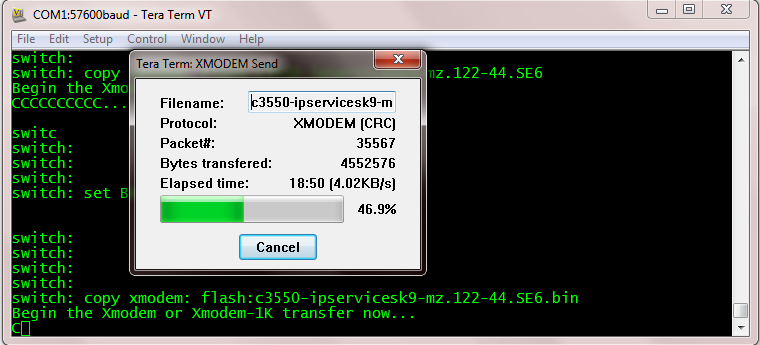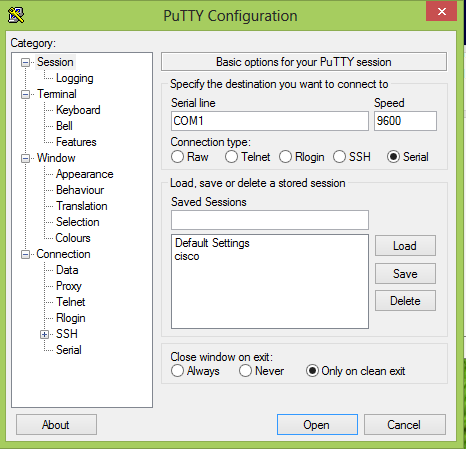Putty Xmodem File Transfer
During my daily working, I do the development on Windows OS; besides, we have aDebian server for running different jobs automatically, file storage, etc.Sometimes, we also need to transfer files from Windows OS to Linux OS, orreverse; in this case, we use Putty to realize the transfering. Today, I willtalk about how to use Putty for transfer files with the following points:
XMODEM is a simple file transfer protocol which became extremely popular in the early bulletin board system (BBS) market, largely because it was so simple to implement. XMODEM was later replaced by.you guessed it: YMODEM.and then ZMODEM. XMODEM is an old, slow transfer protocol. So why would we ever use it? It is a fork of the classic PuTTY telnet/ssl client software that also supports “vintage” transfer protocols such as XModem. Once you have it installed it is pretty easy to establish a serial connection at 115200, 8, n, 1, as specified by Soekris. While PuTTY does support a serial connection, it doesn't have an XMODEM file transfer option. In the ATLAS, once you make the selection for it to either 'Load and Use Config' or 'Save Config Remotely,' you must then have your VT100 program either transmit the file or receive the file using XMODEM.
- What is Putty ?
- Requirements
- Transfering files from Windows to Linux
- Transfering files from Linux to Windows
What is Putty ?
PuTTY is a free and open-source terminal emulator, serial console andnetwork file transfer application. It supports several network protocols,including SCP, SSH, Telnet, rlogin, and raw socket connection. It can alsoconnect to a serial port. The name “PuTTY” has no official meaning.
Requirements
- Windows OS
- Linux OS
- Putty installed: download Putty here
- Putty PSCP installed: download Putty PSCP here
Transfering files from Windows to Linux
To transfer files from Windows OS to Linux OS, we will apply PSCP. Before westart, let’s have a general understanding of it. PSCP means “PuTTy SecureCopy Protocol (PSCP)”, is a tool for transferring files securely betweencomputers using an SSH connection. To use this utility, we should becomfortable working in the Windows Command Prompt.

Now, let’s start to transfer files to Linux:
- Open Windows Command Prompt.
- Type
pscp source_path user_name@host:target_pathat the prompt
Here, ./weekly_report.xlsx specifies the path of source file, xxx is user’saccount for accessing the Linux server, 123.456.789.0 is the host address,/reporting presents target path.
- After the bash script above, we also need to type the password for accessingthe Linux server.
Transfering files from Linux to Windows
Transfering files from Linux OS to Windows OS is similar to the steps above:
Putty Xmodem File Transfer App
- Open Windows Command Prompt.
- Type
pscp user_name@host:source_path target_pathat the prompt

- Same as above, after the bash script above, we also need to type the passwordfor accessing the Linux server.
Conclusion

Does Putty Support Xmodem
In this blog, I introduced how to use Putty to transfer files from Windows OSto Linux OS and reverse. Hope it’s useful for you.
Reference
- “PuTTY”, wikipedia. [Online]. Available: https://en.wikipedia.org/wiki/PuTTY
- “Transfer Files Using PuTTY”, it.cornell.edu. [Online]. Available: https://it.cornell.edu/managed-servers/transfer-files-using-putty
- Comfreak, “traffic information superhighway”, pixabay.com. [Online]. Available: https://pixabay.com/photos/traffic-information-superhighway-3524185/
Chapter 3: Using PuTTY. If your serial port is connected to another computer which has a. These options are not available in the file transfer tools PSCP and. Keywords: Serial port communication in Windows 7 using Hyper-terminal and Putty, Putty, Hyper terminal in Windows 7 Some times you need to access serial. File transfer via XMODEM / YMODEM (and RS-232. (or YMODEM) file transfer uses a special. Expect to receive an acknowledge character over the serial port.
Putty Xmodem File Transfer
I'd like to send the text content of a file over the serial port, over PuTTY. I know that extensions exists such as Xmodem and Zmodem, but they all use some checksum protocols to confirm that a file is sent over the port. However, my requirements are more simple. I'd like to simply send a bunch of text (in a file) over the serial port in Windows (under Linux this would be must more simple), but my preferred terminal program is PuTTY.
3.7 Connecting to a local serial line. PuTTY can connect directly to a local serial line as an alternative to making a network connection. In this mode, text typed into the PuTTY window will be sent straight out of your computer's serial port, and data received through that port will be displayed in the PuTTY window.
Is this possible? Is there another terminal program that has this type of feature built it?
I am looking for a way to transfer a file over from my Windows 8 computer to a (has OMAP Ubuntu on it) using a serial cable. The solution should work in general for any ARM board, so for that reason I am using the serial port. However I am unable to transfer over a file. If I'm not mistaken SCP and PuTTY don't allow the transfer of a file over a serial port.
Or I'm trying it in a wrong way. I have also tried HyperTerminal on Windows 8, but I keep having time-outs when using the file transfer for whatever protocol I select (XModem, Zmodem, etc.).
I have the right specifications for serial port communication as I am able to use PuTTY to access the device and communicate with it. Any suggestions? The best solution would be one that works for Ubuntu/Linux as well. Warning: This approach (cat) tends to be less reliable than other approaches that do error correction. Even when things work well, I've found that serial connections tend to have errors sometimes.
This might be okay for transferring a small bit of data, like an executable file that can do better file transfers, but I wouldn't use it much. The question is tagged Windows 8. Offhand, I would probably recommend SyncTerm or PuTTY, namely due to problems with HyperTerm (known terminal emulation shortcomings, and I don't know that the was-free HyperTerm is licensed for newer Operating systems).
– Oct 31 '15 at 7:44 •. For serial communications, like XModem/ZModem, I'd start with just basic communication. Can you get into a terminal program, and type on one end, and see the other end? If not, you may have issues that cannot be resolved with software: states, 'we offer one hint: just because the ends plug in doesn't mean it will work.' So start by verifying that hardware works okay. If so, then also verify the basic communications settings: communication at 2400 or 9600 might be more prone to work with many hardware than 115200.
8N1 is a very common setting, 7E1 a bit less so, but such settings must match. Whenever I've used SCP, it's been using TCP/IP, which means that an IP address must be assigned to both sides. That is a totally different communication design than trying to use raw serial communications like ZModem.
Using IP will probably be easier once you've got IP working, although getting to the point of having IP working might be a bit more challenging overall, so ZModem may be an excellent choice. I typically avoid XModem; some XModems don't even transfer the right number of bytes (but round up to a half-kilobyte), and don't transmit the filename. However, if you do use XModem (or YModem, but especially XModem), there are a number of variations, so you need to make sure you're using the same one. ZModem is typically more compatible with other ZModem implementations.